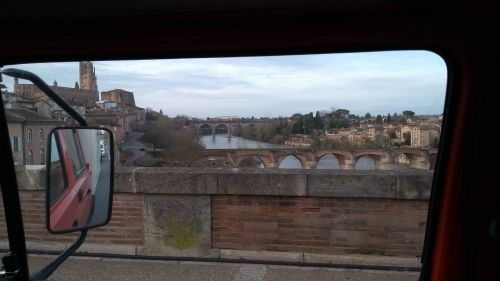Von einem gewissen Standpunkt aus bin ich heute nicht gefahren…
Zumindest wenn man betrachtet wo mein Auto gestern zum Schlafen stand und wo es heute steht.
Tatsächlich hab ich es zumindest ein kleines bisschen bewegt, wenn auch lediglich ca 30km.
Nachdem ich ausgiebig und gemütlich Kaffee gekocht und gefrühstückt hatte ging es erstmal ein wenig daran das Auto aufzuräumen.
Ein wenig ist gut, aufgestanden bin ich um 9, fertig mit Frühstücken war ich um 10 (oder halb elf, wer weiß das schon so genau) und nach dem Aufräumen war es dann plötzlich 12. Angefangen hab ich damit Zeug aus dem Auto zu räumen damit ich den HiLift und den Dieselkanister ebenfalls raus und in ihre entsprechenden Halter verfrachten konnte. Nachdem das geschafft war ein bisschen Werkzeug und Kisten hin und her schieben und dabei noch zwei leere Kartons finden, die wurden dann später mit anderen Müll zusammen an der nächsten Tankstelle in den Container geworfen.
Da ich am Dienstag vor der Abfahrt zwar noch zwei Auffahrrampen als Sandblech Ersatz gekauft hab, auf die schnelle aber keine Halterung für auf den Dachträger mehr fertigen konnte müssten diese wohl oder übel auf der Rückbank bzw im Fußraum davor Platz finden… Jetzt liegen sie wenigstens ordentlich im Fußraum und die Rückbank ist nichtmehr in drei Schichten voll sondern nur in einer halben, Innenraum kann also auch mehr oder weniger genutzt werden (zumindest Füße hoch legen ist kein Problem).
Nach so einem produktiven Vormittag wurde es dann auch Zeit den Motor zu starten und eine Runde zu drehen. Zuerst auf die andere Seite der Autobahn (ja ich stehe quasi neben der Autobahn) um bei der Tankstelle wie angesprochen den Müll zu entsorgen und dann zur Stadt Tabernas hoch und von dort ein wenig in die Richtung dessen was auf der Karte als „Wüste von Tabernas“ eingezeichnet ist, vielleicht findet sich ja ein schönerer Stellplatz… Nach ca 15km und einigen Blicken auf diverse Karten und Apps wurde klar, hier finde ich (zumindest auf entspannte Art und Weise) nichts, also Retoure. Zumindest die Aussicht ist toll
Zumindest die Aussicht ist toll
Und da das deutsche Pärchen gestern gesagt hast dass sie einen Platz etwas weiter die Rambla entlang anfahren wollen der nicht so windig ist und es letzte Nacht schon sehr geschüttelt hat war das die nächste Idee, also rein in die Rambla und solange ich die Spuren des Mercedes gesehen hab immer hinterher. Leider habe ich die Spuren dann verloren und auch keinen erkennbar guten Standplatz gesehen also blieb nur ein weiteres mal wenden und zurück zum Ausgangspunkt. In der Rambla
In der Rambla
Zurück an meinem Ausgangspunkt wurde erstmal aus den Resten vom gestrigen Abendessen ein neues (mehr oder weniger) Mittagessen gezaubert und dann einfach das schöne Wetter (strahlender Sonnenschein und irgendwas um die 20°C) genossen.
Als dann langsam aber sicher die Sonne begann unterzugehen noch kurz ein Foto gemacht So
So
Und dann ein wenig für morgen bzw die nächsten Tage Pläne geschmiedet, aber dazu dann mehr wenn es soweit ist.











